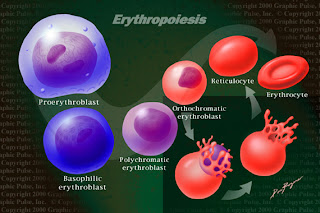Characteristics and functions
Mammalian erythrocytes have no nucleus so DNA. Mammalian erythrocyte shape bikonkaf , which forms the center of the disc with a slightly flattened . This form is to optimize the exchange of oxygen. Color depending on the hemoglobin of erythrocytes.Function is to assist erythrocyte hemoglobin binds oxygen. If the hemoglobin binds oxygen, the erythrocytes berwarnah red, and if the oxygen released by hemoglobin is bluish red erythrocytes.
Levels of hemoglobin (Hb) in the blood of a person varies, depending on sex and age of a person. In the normal condition of men dewsa Hb 13-18 g per 100 ml (g / ml). Hb levels of adult women is 12-16 (g / ml), while the baby is 14-20 (g / ml) of blood.
Erythrocytes also catalyze the reaction between carbon dioxide (CO ₂) and water, because erythrocytes contain carbonic anhydrase in large numbers. This reaction allows the blood to react with CO ₂ and transport from tissues to the lungs.
The number of erythrocytes also varies, depending on sex, age, and height of a person's residence. The number of erythrocytes in normal males from 5.1 to 5.8 million per cubic milliliter of blood and normal in women from 4.3 to 5.2 million per cubic milliliter of blood. People who live in the highlands tend to have more erythrocytes. Erythrocytes can be reduced more because there are a lot of wounds that bleed and anemia. Seseorag activity will affect the blood circulation so that oxygen is removed will vary for each person (Marieb, 2004; Solomon et al. 2005).
Formation of erythrocytes
The process of formation of red blood cells is called erythropoiesis . In the few weeks of life of the embryo in the womb, erythrocytesproduced from yolk sac. Several months later, the formation of erythrocytes occurs in the liver, spleen, and lymph glands. After the baby is born erythrocytes in the form of the bone marrow. Erythrocyte production stimulated by the hormone erythropoietin . Approximately at the age of 20 years, marrow in the proximal long bones are no longer in production. Most of the erythrocytes is derived from membranous bone marrow (spine, chest, ribs, and pelvis). With increasing age, bone marrow becomes less productive.








2 التعليقات:
Thanks for the sharing. I'm wondering is it similar to Embryonic Stem Cells
Generally, red blood cells are derived from haemopoietic stem cells in bone marrow, which follows a series of maturation steps. Alfa Chemistry
إرسال تعليق